 W
WDuring the Australian gold rushes, significant numbers of workers relocated to areas in which gold had been discovered. Gold was found several times in Australia before 1851, but there were only gold rushes from 1851 onwards, mainly because the colonial government of New South Wales had previously suppressed news of gold finds which it believed would reduce the workforce and destabilise the economy.
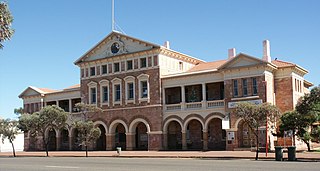 W
WCoolgardie is a small town in Western Australia, 558 kilometres (347 mi) east of the state capital, Perth. It has a population of approximately 850 people.
 W
WThe Shire of Croydon is a local government area in western Queensland, Australia. The shire, administered from the town of Croydon, covers an area of 29,498 square kilometres (11,389.2 sq mi). The council consists of a mayor plus four councillors, each of whom represents the entire Shire.
 W
WGold Escorts were common across Australian goldfields, transporting mined and processed material from mines to banks and mints across the country.
 W
WThe Goldfields Water Supply Scheme is a pipeline and dam project that delivers potable water from Mundaring Weir in Perth to communities in Western Australia's Eastern Goldfields, particularly Coolgardie and Kalgoorlie. The project was commissioned in 1896 and completed in 1903.
 W
WHill End is a former gold mining town in New South Wales, Australia. The town is located in the Bathurst Regional Council local Government area.
 W
WThomas Hiscock (1812–1855) was an English blacksmith and prospector who settled in Australia in the 1840s. He is best-remembered today for helping to spark the Victorian Gold Rush with his discovery of gold outside the town of Buninyong, near Ballarat.
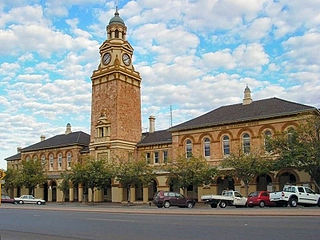 W
WKalgoorlie is a city in the Goldfields-Esperance region of Western Australia, located 595 km (370 mi) east-northeast of Perth at the end of the Great Eastern Highway. It is sometimes referred to as Kalgoorlie-Boulder, as the surrounding urban area includes the historic townsite of Boulder and the local government area is the City of Kalgoorlie-Boulder.
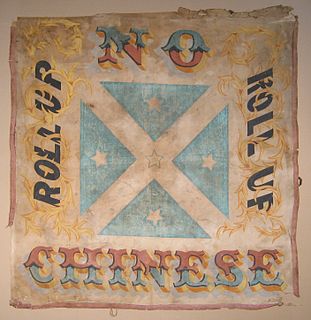 W
WThe Lambing Flat Riots (1860-1861) were a series of violent anti-Chinese demonstrations that took place in the Burrangong region, in New South Wales, Australia. They occurred on the goldfields at Spring Creek, Stoney Creek, Back Creek, Wombat, Blackguard Gully, Tipperary Gully, and Lambing Flat.
 W
WMaldon is a town in Victoria, Australia, in the Shire of Mount Alexander local government area. It has been designated "Australia's first notable town" and is notable for its 19th-century appearance, maintained since gold-rush days. At the 2016 census, Maldon had a population of 1,513.
 W
WHenry Beaufoy Merlin (1830–1873) was an Australian photographer, showman, illusionist and illustrator. In the 1850s he worked as a theatrical showman and performer in Sydney, Newcastle and Maitland. In 1863 he was the first person to introduce Pepper's ghost to Australia. After this, he took up photography and between 1869 and 1872 turned the American Australasian Photographic Company into one of the most respected studios in Australia. Between 1872 and 1873 he worked extensively documenting the goldfields and mining towns of New South Wales. In 1873, as an employee of Bernhardt Holtermann, he photographed Sydney and many rural New South Wales towns. He died on 27 September 1873.
 W
WThe Palmer River is a river located in Far North Queensland, Australia. The area surrounding the river was the site of a gold rush in the late 19th century which started in 1873.
 W
WThe Perth Mint is Australia's official bullion mint and wholly owned by the Government of Western Australia. Established on 20 June 1899, two years before Australia's Federation in 1901, The Perth Mint was the last of three Australian colonial branches of the United Kingdom's Royal Mint intended to refine gold from the gold rushes and to mint gold sovereigns and half-sovereigns for the British Empire. Along with the Royal Australian Mint, which produces coins of the Australian dollar for circulation, The Perth Mint is the older of the two mints issuing coins that are legal tender in Australia.
 W
WSandstone is a small town in the Mid West region of Western Australia 157 kilometres (98 mi) east of Mount Magnet and 661 kilometres (411 mi) north of the state capital, Perth. At the 2016 census, Sandstone and the surrounding Shire of Sandstone had a population of 89 people, including 19 families. Sandstone is the administrative centre and only town in the Shire of Sandstone local government area.
 W
WSofala is a village in New South Wales, Australia, 255 kilometres (158 mi) north-west of Sydney, within Bathurst Regional Council. It is located beside the Turon River. Sofala is just off the Bathurst-Ilford Road, with only local traffic through the town itself. At the 2006 census, Sofala had a population of 208.
 W
WSteiglitz is a small settlement in the Brisbane Ranges in Victoria. It is located 92 kilometres (57 mi) west of the state capital, Melbourne, Australia. At the 2016 census, the Steiglitz area had a population of 53.
 W
WTuron River, a perennial stream that is part of the Macquarie catchment within the Murray–Darling basin, is located in the central western district of New South Wales, Australia. Partly situated in the Turon National Park, the river is host to numerous recreational and tourist activities such as horse riding, gold panning, canoeing, camping, and seasonal fishing.
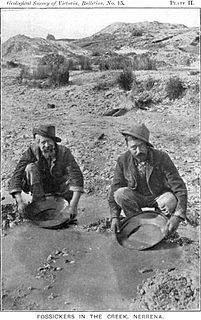 W
WThe Victorian gold rush was a period in the history of Victoria, Australia approximately between 1851 and the late 1860s. It led to a period of extreme prosperity for the Australian colony, and an influx of population growth and financial capital for Melbourne, which was dubbed "Marvellous Melbourne" as a result of the procurement of wealth.
 W
WThe Welcome Nugget is a large gold nugget, weighing 2,217 troy ounces 16 pennyweight. (68.98 kg), that was discovered by a group of twenty-two Cornish miners at the Red Hill Mining Company site at Bakery Hill in Ballarat, Victoria, Australia, on 9 June 1858. It was located in the roof of a tunnel 55 metres (180 feet) underground. Roughly shaped like a horse's head, it measured around 49 cm (18 in) long by 15 cm (6 in) wide and 15 cm (6 in) high, and had a roughly indented surface. It was assayed by William Birkmyre of the Port Phillip Gold Company and given its name by finder Richard Jeffery. Eclipsed by the discovery of the larger Welcome Stranger eleven years later in 1869, it remains the second largest gold nugget ever found.
 W
WThe Welcome Stranger is the biggest alluvial gold nugget found, which had a calculated refined weight of 97.14 kilograms (3,123 ozt). It measured 61 by 31 cm and was discovered by prospectors John Deason and Richard Oates on 5 February 1869 at Moliagul, Victoria, Australia, about 14.6 kilometres north-west of Dunolly.
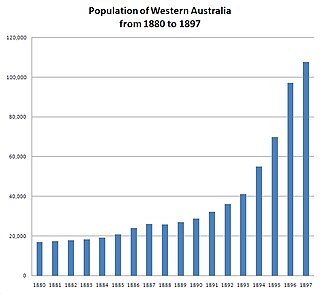 W
WIn the latter part of the nineteenth century, discoveries of gold at a number of locations in Western Australia caused large influxes of prospectors from overseas and interstate, and classic gold rushes. Significant finds included:Halls Creek in 1885, found by Charles Hall and Jack Slattery. Triggered the "Kimberley gold rush". Near Southern Cross in 1887, found by the party of Harry Francis Anstey. The "Yilgarn gold rush". Cue in 1891, found by Michael Fitzgerald, Edward Heffernan and Tom Cue. The "Murchison gold rush". Coolgardie in 1892, by Arthur Bailey and William Ford. Kalgoorlie in 1893, by Patrick "Paddy" Hannan, Tom Flanagan and Dan Shea.
 W
WYalwal is the site of a former gold mining town of the same name situated 29 km (18 mi) west of Nowra at the confluence of the Danjera and Yarramunmun Creeks which then forms Yalwal Creek which flows into the Shoalhaven River. It is now the site of a City of Shoalhaven managed picnic area and Danjera Dam. Yalwal is also the name of a modern locality, which includes the former mining town but extends over an extensive area of forests to its south, which largely forms parts of the Morton National Park. It is also the name of a parish, which lies to the north of the former mining town and generally north of the locality of Yalwal, generally in the area of the modern locality of Ettrema.